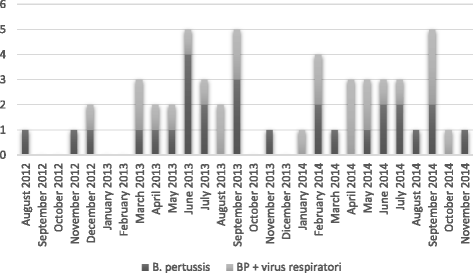Infants hospitalized for Bordetella pertussis infection commonly have respiratory viral coinfections
- PMID: 28701160
- PMCID: PMC5506634
- DOI: 10.1186/s12879-017-2567-6
Infants hospitalized for Bordetella pertussis infection commonly have respiratory viral coinfections
Abstract
Background: Whether viral coinfections cause more severe disease than Bordetella pertussis (B. pertussis) alone remains unclear. We compared clinical disease severity and sought clinical and demographic differences between infants with B. pertussis infection alone and those with respiratory viral coinfections. We also analyzed how respiratory infections were distributed during the 2 years study.
Methods: We enrolled 53 infants with pertussis younger than 180 days (median age 58 days, range 17–109 days, 64. 1% boys), hospitalized in the Pediatric Departments at “Sapienza” University Rome and Bambino Gesù Children’s Hospital from August 2012 to November 2014. We tested in naso-pharyngeal washings B. pertussis and 14 respiratory viruses with real-time reverse-transcriptase-polymerase chain reaction. Clinical data were obtained from hospital records and demographic characteristics collected using a structured questionnaire.
Results: 28/53 infants had B. pertussis alone and 25 viral coinfection: 10 human rhinovirus (9 alone and 1 in coinfection with parainfluenza virus), 3 human coronavirus, 2 respiratory syncytial virus. No differences were observed in clinical disease severity between infants with B. pertussis infection alone and those with coinfections. Infants with B. pertussis alone were younger than infants with coinfections, and less often breastfeed at admission.
Conclusions: In this descriptive study, no associations between clinical severity and pertussis with or without co-infections were found.
Trial registration: Policlinico Umberto I: protocol 213/14, 3085/13.02.2014, retrospectively registered. Bambino Gesù Children’s Hospital: protocol n. RF-2010-2317709.
Background: Whether viral coinfections cause more severe disease than Bordetella pertussis (B. pertussis) alone remains unclear. We compared clinical disease severity and sought clinical and demographic differences between infants with B. pertussis infection alone and those with respiratory viral coinfections. We also analyzed how respiratory infections were distributed during the 2 years study.
Methods: We enrolled 53 infants with pertussis younger than 180 days (median age 58 days, range 17–109 days, 64.1% boys), hospitalized in the Pediatric Departments at “Sapienza” University Rome and Bambino Gesù Children’s Hospital from August 2012 to November 2014. We tested in naso-pharyngeal washings B. pertussis and 14 respiratory viruses with real-time reverse-transcriptase-polymerase chain reaction. Clinical data were obtained from hospital records and demographic characteristics collected using a structured questionnaire.
Results: 28/53 infants had B. pertussis alone and 25 viral coinfection: 10 human rhinovirus (9 alone and 1 in coinfection with parainfluenza virus), 3 human coronavirus, 2 respiratory syncytial virus. No differences were observed in clinical disease severity between infants with B. pertussis infection alone and those with coinfections. Infants with B. pertussis alone were younger than infants with coinfections, and less often breastfeed at admission.
Conclusions: In this descriptive study, no associations between clinical severity and pertussis with or without co-infections were found.
Trial registration: Policlinico Umberto I: protocol 213/14, 3085/13.02.2014, retrospectively registered.
Bambino Gesù Children’s Hospital: protocol n. RF-2010-2317709.
Keywords: Child; Pertussis; Respiratory virus; Severity.
Conflict of interest statement
Ethics approval and consent to participate
Before infants were enrolled, all children’s parents agreed and gave written informed consent to participate in the study, which was approved by institutional review boards at both hospitals (Policlinico Umberto I: protocol 213/14, 3085/13.02.2014; Bambino Gesù Children’s Hospital: protocol n. RF-2010-2317709).
Consent for publication
Not applicable.
Competing interests
The authors declare that they have no competing interests.
Publisher’s Note
Springer Nature remains neutral with regard to jurisdictional claims in published maps and institutional affiliations.
Figures
References
-
- Adams DA, Thomas KR, Jajosky RA, Foster L, Sharp P, Onweh DH, et al. Nationally Notifiable Infectious Conditions Group. Summary of Notifiable Infectious Diseases and Conditions - United States. MMWR Morb Mortal Wkly Rep. 2014. 2016;63(54):1–152. - PubMed
-
- Marti M. Pertussis vaccines: WHO position paper, August 2015 - Recommendations. Vaccine. 2015;34:1423–1425. - PubMed
Publication types
MeSH terms
Substances
LinkOut - more resources
Full Text Sources
Other Literature Sources
Medical


